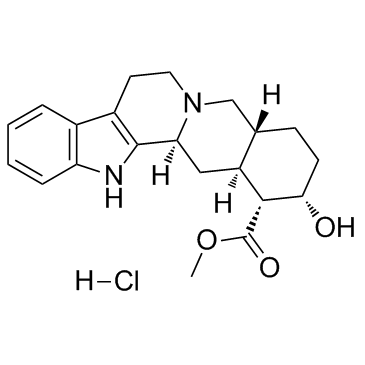Yohimbine hydrochloride

Yohimbine hydrochloride structure
|
Common Name | Yohimbine hydrochloride | ||
|---|---|---|---|---|
| CAS Number | 65-19-0 | Molecular Weight | 390.904 | |
| Density | N/A | Boiling Point | 542.979ºC at 760 mmHg | |
| Molecular Formula | C21H27ClN2O3 | Melting Point | 288-290 °C (dec.)(lit.) | |
| MSDS | Chinese USA | Flash Point | 282.184ºC | |
| Symbol |

GHS06 |
Signal Word | Danger | |
Use of Yohimbine hydrochlorideYohimbine hydrochloride is an alpha 2-adrenoreceptor antagonist, blocking the pre- and postsynaptic alpha-2 adrenoreceptors and causing an increased release of noradrenaline and dopamine.IC50 value:Target:In vitro:In vivo: Yohimbine hydrochloride (0.2 mg/kg, i.p.) was administered to rats 1h before the stress session daily for 14 consecutive days and its effect was assessed. Results of this section revealed that, immersion of rats in cold water significantly decreased sexual arousal and motivation as indicated by increased latencies and intervals. Decreased copulatory activity was confirmed by decreased testosterone, luteinizing hormone (LH) and follicle-stimulating-hormone (FSH) levels as well as decreased cholesterol content in rat testes. Treatment with yohimbine significantly increased the sexual arousal and potency and corrected the effects induced by stress on the mating behavior of male rats [1]. |
| Name | Yohimbine hydrochloride |
|---|---|
| Synonym | More Synonyms |
| Description | Yohimbine hydrochloride is an alpha 2-adrenoreceptor antagonist, blocking the pre- and postsynaptic alpha-2 adrenoreceptors and causing an increased release of noradrenaline and dopamine.IC50 value:Target:In vitro:In vivo: Yohimbine hydrochloride (0.2 mg/kg, i.p.) was administered to rats 1h before the stress session daily for 14 consecutive days and its effect was assessed. Results of this section revealed that, immersion of rats in cold water significantly decreased sexual arousal and motivation as indicated by increased latencies and intervals. Decreased copulatory activity was confirmed by decreased testosterone, luteinizing hormone (LH) and follicle-stimulating-hormone (FSH) levels as well as decreased cholesterol content in rat testes. Treatment with yohimbine significantly increased the sexual arousal and potency and corrected the effects induced by stress on the mating behavior of male rats [1]. |
|---|---|
| Related Catalog | |
| References |
[1]. Saad MA, et al. Potential effects of yohimbine and sildenafil on erectile dysfunction in rats. |
| Boiling Point | 542.979ºC at 760 mmHg |
|---|---|
| Melting Point | 288-290 °C (dec.)(lit.) |
| Molecular Formula | C21H27ClN2O3 |
| Molecular Weight | 390.904 |
| Flash Point | 282.184ºC |
| Exact Mass | 390.171021 |
| PSA | 65.56000 |
| LogP | 3.38700 |
| Index of Refraction | 103 ° (C=1, H2O) |
| Storage condition | 2~8°C |
CHEMICAL IDENTIFICATION
HEALTH HAZARD DATAACUTE TOXICITY DATA
|
| Symbol |

GHS06 |
|---|---|
| Signal Word | Danger |
| Hazard Statements | H300-H311-H331 |
| Precautionary Statements | P261-P264-P280-P301 + P310-P311 |
| Personal Protective Equipment | Eyeshields;Faceshields;Gloves;type P2 (EN 143) respirator cartridges |
| Hazard Codes | T |
| Risk Phrases | R23/24;R33 |
| Safety Phrases | S22-S36/37/39-S45-S24/25 |
| RIDADR | UN 1544 6.1/PG 2 |
| WGK Germany | 3 |
| RTECS | ZG1015000 |
| Packaging Group | II |
| Hazard Class | 6.1(a) |
| HS Code | 2933990090 |
| HS Code | 2933990090 |
|---|---|
| Summary | 2933990090. heterocyclic compounds with nitrogen hetero-atom(s) only. VAT:17.0%. Tax rebate rate:13.0%. . MFN tariff:6.5%. General tariff:20.0% |
|
Chemical genetics reveals a complex functional ground state of neural stem cells.
Nat. Chem. Biol. 3(5) , 268-273, (2007) The identification of self-renewing and multipotent neural stem cells (NSCs) in the mammalian brain holds promise for the treatment of neurological diseases and has yielded new insight into brain canc... |
|
|
Comparison of liquid chromatography and supercritical fluid chromatography coupled to compact single quadrupole mass spectrometer for targeted in vitro metabolism assay.
J. Chromatogr. A. 1371 , 244-56, (2014) The goal of this study was to evaluate the combination of powerful chromatographic methods and compact single quadrupole MS device for simple in vitro cytochrome P450 (CYP) inhibition assay, instead o... |
|
|
Genetic mapping of targets mediating differential chemical phenotypes in Plasmodium falciparum.
Nat. Chem. Biol. 5 , 765-71, (2009) Studies of gene function and molecular mechanisms in Plasmodium falciparum are hampered by difficulties in characterizing and measuring phenotypic differences between individual parasites. We screened... |
| UNII-NB2E1YP49F |
| Yohimbe HCl |
| (16α,17α)-17-Hydroxyyohimban-16-carboxylate de méthyle chlorhydrate |
| (1R,2S,4aR,13bS,14aS)-2-Hydroxy-1,2,3,4,4a,5,7,8,13,13b,14,14a-dodécahydroindolo[2',3':3,4]pyrido[1,2-b]isoquinoléine-1-carboxylate de méthyle chlorhydrate |
| Yohimbine hydrochloride |
| Methyl (16α,17α)-17-hydroxyyohimban-16-carboxylate hydrochloride |
| Methyl (16α,17α)-17-hydroxyyohimban-16-carboxylate hydrochloride (1:1) |
| MFCD00012674 |
| Yohimbine HCl |
| Yohimban-16-carboxylic acid, 17-hydroxy-, methyl ester, (16α,17α)-, hydrochloride (1:1) |
| Yohimban-16α-carboxylic acid, 17α-hydroxy-, methyl ester, monohydrochloride |
| Antagonil |
| Yohimban-16α-carboxylic acid, 17α-hydroxy-, methyl ester, monohydrochloride (8CI) |
| Aphrodyne |
| Methyl (1R,2S,4aR,13bS,14aS)-2-hydroxy-1,2,3,4,4a,5,7,8,13,13b,14,14a-dodecahydroindolo[2',3':3,4]pyrido[1,2-b]isoquinoline-1-carboxylate hydrochloride |
| EINECS 200-600-4 |
| Methyl-(1R,2S,4aR,13bS,14aS)-2-hydroxy-1,2,3,4,4a,5,7,8,13,13b,14,14a-dodecahydroindolo[2',3':3,4]pyrido[1,2-b]isochinolin-1-carboxylathydrochlorid |
| Yohimbine monohydrochloride |
| Yohimbine (Hydrochloride) |

